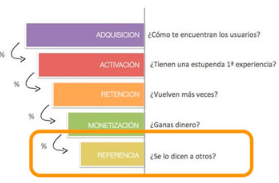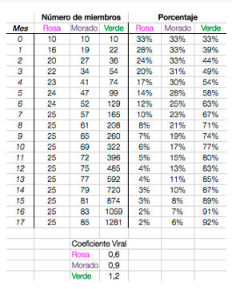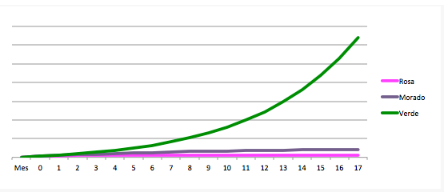VIRAL SALES TO ACHIEVE EXPONENTIAL GROWTH
Accelerate your business with these expert tips on "Viralising your sales for exponential growth". Analyse and discover this TIP!
The virality is a powerful factor that can accelerating growth of a company in a significant way. Achieving sales virality is fundamental for any business looking for a rapid and effective growth.
How to grow by leveraging virality in sales?
- Analyse User Data and Behaviour: Use analytics tools to track how users interact with your product or service. Identify which features or content generate the most interaction and consider how they could be improved to increase virality.
- A/B Testing to Optimise the Conversion Funnel: uses A/B testing to adjust and improve each stage of the conversion funnel. Each improvement in the funnel increases the effectiveness of the viral coefficient.
- Identify and Activate Promoters: leverages Net Promoter Score (NPS) metrics to identify the most satisfied customers and find ways to encourage them to share their enthusiasm with others.
- Improve the product based on feedback: uses user feedback to make constant improvements. A product that meets or exceeds customer expectations is more likely to be shared.
- User Retention: Virality is not only about acquiring new users but also about retaining existing ones. A satisfied, repeat user is more likely to refer new users.
- Gamification: introduce gamification elements that encourage users to perform actions that increase virality, such as sharing content, inviting friends, etc.
- Incentives and Rewards: As you mentioned, offering incentives for sharing can be a powerful driver of virality. This could include discounts, access to premium features, etc.
- Monitor and Adjust: virality is a moving target. What worked yesterday may not work tomorrow. It is essential to keep monitoring metrics and be willing to adapt quickly.
Is it possible to measure virality?
Definitely yes.
HERE ARE SOME ADDITIONAL METRICS THAT COULD BE CONSIDERED:
- Time to Conversion: How long does it take on average from the time a user learns about your product until they take a desired action, such as making a purchase or registering?
- User Cohorts: Dividing users into cohorts based on when they joined will allow you to see how different strategies affect virality over time.
- Customer Acquisition Cost (CAC) (+) versus Customer Lifetime Value (LTV): if LTV exceeds CAC and you have a high viral quotient, you are in an excellent position to grow.
Recalling that the virality is a growth metrics that feeds back into the capacity to acquire new userscompanies that achieve a coefficient The high viral emissions are well positioned to experience significant growth. And as mentioned, if the coefficient is greater than 1you are in a territory of exponential growthwhich is the ultimate goal of many startups and growing companies.
The viral coefficient... Is it possible to measure virality?
If there is one factor that can transform a business model is virality. This is a feature capable of producing surprising growths with exponential curves... but although there is a mythical aura about the viral element, in reality it is a factor which can be measuredis the first step before it can be improved. Do you know how to do it?
As I think is obvious, I am a lover of metrics, because I believe that "The first step to be able to improve something is to be able to measure it". as Drucker said. And that's why often when I work with clients they are surprised that we manage to establish metrics for the viral factor, as it has become a mythical element that only seems to appear if the gods are favourable.
Although it is not the ultimate aim of this post to set out the factors that lead to virality (there are great articles on how to implement or design virality), but we will try to isolate the factors that lead to virality (there are great articles on how to implement or design virality), but we will try to isolate the factors that lead to virality. buildand, above all, we will establish a metric: the famous viral coefficient or k-factor.

For me, the first step is to understand that virality it really is (usually) the last step of the conversion funnel of a business model (+), and that we must therefore understand that it is a growth metric... as it feeds back into the capacity for user acquisition: the greater the virality, the greater the number of new users.
WHAT IS THE VIRAL COEFFICIENT AND HOW TO MEASURE IT?
Most people, when it comes to measuring virality alone measures aspects directly related to their ego, such as the number of invitations sent, the number of shares of the content on the social network in question or the number of views of a video.... but what about the underlying viralisation process? That is where the key element to measure lies.
And yes, I am talking in general about technology-based business models. Not because virality does not exist in "physical" business models or because it cannot be measured, but because the process is much more complicated, given that a key factor is missing: traceability (and that more complex tactics have to be used to implement them, such as affiliation or bonuses, discounts x invitation...etc.).
THE VIRAL QUOTIENT, OR AT LEAST THE DEFINITION I LIKE BEST FROM JEREMY LIEW, IS:
"It represents a site's capacity for viral growth, and measures the average number of new users a current user is able to bring in.
NOTHING BETTER THAN AN EXAMPLE TO UNDERSTAND THIS
Imagine a platform with 3 user profiles or types of users: the PINK, the PURPLE and the GREEN.
Each group starts with 10 users, but has different viral coefficients: PINK=0.6, PURPLE=0.9 and GREEN=1.2. Over time see what happens to the percentages of users in each group.
As you can see, the difference is abysmal, and in a very short time, GREEN users are growing dramatically.
FIRST CONCLUSION

"If the viral coefficient is >1, the platform is exponential and organic (i.e. each user brings at least one new user). If it is less than 1, the platform is growing linearly.

IN REALITY, THERE ARE TWO WAYS TO MEASURE THIS VIRAL COEFFICIENT:
- Projects where it is possible to measure invitations or viralisation: i.e. in projects where, when launching a new invitation or sharing something, it is possible to uniquely identify the user who has invited. For example, with platforms where each invitation has a special and traceable URL, so that we can attribute it to a specific user. In this type of scenario there are two basic metrics to build the virality coefficient.
- Invitation ratio: Measure the average number of invitations sent by platform users in a given period. The only "natural" way to improve it is to make your product or service so great that people want to recommend it to their friends.
- For example, during the summer period on the platform of one of my clients (a project that operates with the usual invitation concept) approx. 112,000 invitations were sent out, which represents 2.07 invitations per user (there were 54,000 at the start of the period, so 112,000/54,000).
- Acceptance rate: Measures the percentage of accepted invitations (or conversion ratio of invitations accepted vs. invitations sent). The clearer and more powerful the invitation, the registration process and the incentives for acceptance, the higher the ratio.
- For example, at the previous client the acceptance rate during the summer was 27%, which means that a little more than 1 out of 4 invitations ends up in the registration of a new user...
IN THIS TYPE OF PROJECT, THE FORMULA FOR CALCULATING THE VIRAL COEFFICIENT IS VERY SIMPLE (WHERE U IS "USERS"):
"U. Viral U. = Initial U. x Invitation Ratio x Acceptance Ratio
Viral Coefficient= Viral U. / Initial U.".
In the case of my client, which started with 54,000 users before the summer, and if we apply the above formula, we see that in total 30,240 new users were gained on a lifetime basis (54,000 x 2.07 x 27%, a respectable but linear figure), which implies a lifetime ratio of 0.56 (30,240/54,000). For the viral coefficient to be 1, its users would have to have sent 200,000 invitations or have achieved an acceptance rate of just over 48%.
AN ALTERNATIVE WAY OF CALCULATING THE VIRAL COEFFICIENT IS:
"Viral coefficient = average number of invitations x acceptance rate".
- Projects where traceability is not straightforward: eThat is to say, although the personalised invitation method is ideal, in some environments it is simply not feasible to have a personalised invitation. Also... What about the users who talk about us on social media? What about word of mouth? For these projects, a less exact but more pragmatic approach is advisable: We will divide the users into two large groups - one where we will include all those we have attracted proactively (i.e. via campaigns, SEO, SEM, affiliates...) and on the other hand the other users, who we will consider to have come "on their own" (viral users).
IN THIS SCENARIO, THE VIRAL COEFFICIENT WILL BE:
"Viral Coefficient= Viral Users / Attracted Users".
- Attention to one detail (which is mentioned in Internet Marketing Thoughts): given that on average there are 20% of events (campaigns, SEO, SEM...) that are not counted, we should increase the number of "attracted" users by 20%.
- Another important factor to measure is viral speed, and it has to do with the average time that passes from the time the user launches the invitation until the user on the other side confirms their acceptance of it (either through a registration or similar). The higher it is, not only will we have a model that grows exponentially organically, but also very quickly.

As I think it is clear, virality is a key element in many types of business models, but we must not only be able to measure it but also to act on its "levers". (which we will talk about on another occasion). If we manage to do so, we can work with a business model that grows in an unattended and exponential way...
Of course, the viral coefficient varies over time, and what is a perfectly viral environment today may not be so tomorrow (for example, the viral coefficient of Facebook in its early days has nothing to do with what it is today).
TIPS TO IMPROVE THE VIRALITY OF YOUR SALES:
- Offer a good product or service: customer satisfaction is the key to a positive recommendation.
- Incentives to refer others: offer incentives to customers for referring friends or relatives, such as discounts or rewards.
- Building a community: develop strong customer relationships through events, loyalty programmes, social media, etc.
- Clear communication: keep customers informed about new products or promotions and answer their questions in a timely manner.
- Ease of sharing: make it easy for customers to share your products or services with their friends and family, e.g. through referral links or social networks.
- Delivering an excellent experience: create a positive customer experience from the first interaction until after the sale.
PRACTICAL EXAMPLES OF COMPANIES THAT HAVE HARNESSED VIRALITY TO GROW RAPIDLY:
DROPBOX
It is perhaps one of the most cited examples when it comes to viral growth. They offered additional storage space to both the referrer and the referred when an existing user invited someone new to the platform. This simple but effective approach helped Dropbox grow exponentially in a short period of time.
AIRBNB
It used viral tactics to grow. Users could share a referral link with friends and family, and both would get travel credit when the referral completed their first trip or accommodation. This incentivised users to actively share the platform.
UBER
It used a similar approach to Airbnb, offering free or discounted travel for referrals and referrals. This method not only attracted new users but also incentivised existing users to continue using the service.
ROBINHOOD
The Robinhood stock trading app offered a free share when new users joined via an invitation from an existing user. This created a viral cycle where users were motivated to invite friends and family.
HOTMAIL
Although an older example, it is worth mentioning. Hotmail included a line in every email sent through its service that read "Get your free email at Hotmail". This resulted in a viral effect, and Hotmail gained tens of millions of users in a very short period of time.
SLACK
The team communication tool grew largely through internal virality. Within a company, once one team started using Slack, the ease of use and powerful features led to other teams adopting the tool as well.
CALENDLY
A meeting scheduling tool, it takes a more subtle but effective approach. Each time someone receives an invitation to schedule a meeting through Calendly, they are exposed to the product and can consider using it for their own scheduling needs.
ZOOM
Zoom's rapid rise during the COVID-19 pandemic can be attributed in part to its easy-to-use, easy-to-share product approach. The ease of joining meetings and the stability of the platform caused word-of-mouth recommendations to skyrocket.
These examples show how different virality tactics can be applied in different industries and contexts. However, theyWhat they all have in common is an understanding of their users and the provision of a clear and valuable incentive to share.
VIRALITY IN SALES HAS THE POTENTIAL TO ACCELERATE A COMPANY'S GROWTH FOR SEVERAL KEY REASONS:
LOW CUSTOMER ACQUISITION COST (CAC)
When existing customers become advocates of your product or service, the cost of acquiring a new customer is significantly reduced. This allows companies to invest more in other areas, such as product development, rather than spending huge sums on marketing and advertising.
EXPONENTIAL EFFECT
Virality creates a positive feedback loop. A satisfied customer shares the product with more people, who in turn share it with even more people. This creates a multiplier effect that leads to rapid growth of the user base, often following an exponential curve.
STRENGTHENING THE BRAND
Word of mouth is one of the most effective forms of advertising. When a product goes viral, it improves brand recognition and credibility, which in turn can lead to increased customer loyalty and long-term retention.
USE OF SOCIAL NETWORKS (+) AND TECHNOLOGY
Modern technology makes it easier than ever to share information. A single tweet, posting on Facebook (+) or video of TikTok (+) can reach thousands, if not millions, of people in a short time. Companies that understand how to leverage these platforms have enormous potential for viral growth.
ACCESS TO NEW MARKETS AND SEGMENTS (+)
When a product or service goes viral, it not only reaches more people within its target market, but often crosses borders and enters new market segments that the company might not have considered before.
PRODUCT IMPROVEMENT
Rapid growth often comes with feedback and suggestions from an expanding user base. This can provide the company with valuable insights to improve and adapt its product, which in turn can further fuel virality.
INCREASED INVESTMENT AND OPPORTUNITIES
Companies that show rapid and viral growth often attract more attention from potential investors and partners, which can lead to new business opportunities and expansion.
In short, virality can be a powerful and effective way to accelerate a company's growth, reduce costs and build a strong brand. However, it is crucial to keep in mind that virality is not easy to achieve and maintain; it requires a high-quality product, a solid strategy and flawless execution.
ARTIFICIAL INTELLIGENCE CAN BE A VALUABLE TOOL TO HELP YOUR BUSINESS GROW EXPONENTIALLY THROUGH VIRAL SALES IN A VARIETY OF WAYS:
24/7 CUSTOMER SERVICE
A chatbot (+) can handle customer enquiries at all times, providing immediate responses and improving customer satisfaction. A satisfied customer is more likely to recommend your product or service to others.
PERSONALISATION
You can programme the chatbot to offer personalised recommendations based on user behaviour and preferences. This personalised experience can impress customers and make them more likely to share your product or service.
AUTOMATION OF THE SALES PROCESS
Artificial intelligence can guide potential customers through the sales funnel, answering questions, resolving objections and ultimately directing the customer towards a purchase, all in an automated way.
DATA COLLECTION AND FEEDBACK
The chatbot can collect valuable information from users, such as their preferences and behaviour, which can then be used to improve the product and adjust marketing strategies. These insights can help you create more effective campaigns that have a greater potential to go viral.
REFERENCE PROGRAMMES
You can use the chatbot to automate and optimise referral programmes. For example, after a successful purchase, the chatbot can ask if the customer would like to refer someone and, if so, handle the entire referral process automatically.
DISTRIBUTION OF VIRAL CONTENT
If you have a marketing campaign or content that has the potential to go viral, the chatbot can be an excellent tool to distribute it. It can send the content to users who are more likely to share it, or even suggest that they share it.
FACILITATING SOCIAL INTERACTION
The chatbot can encourage users to share their experiences on social media, perhaps by offering discounts or promotions as an incentive to share. These interactions can increase visibility and help your product or service go viral.
As your business grows, a chatbot can easily scale to handle a higher volume of interactions without the need to proportionally increase your customer service team, allowing you to maintain a high quality of service even during rapid growth.
In a nutshell, A well-implemented chatbot can offer multiple ways to increase the virality of your sales, improving both customer experience and operational efficiency.
APPLY THIS TIP TO YOUR PROJECT
TASK
CASE STUDY: "ECOFASHION" COMPANY IN THE MENTORDAY ACCELERATION PROGRAMME
CONTEXT
EcoFashion is a startup that produces and sells sustainable and eco-friendly clothing. The company has been selected to participate in MentorDay's accelerator programme and is looking for ways to grow quickly. After identifying an opportunity in the market for sustainable products that are both stylish and affordable, they decide to implement a viral sales strategy.
OBJECTIVES:
- Increase sales by 300% in 6 months.
- Get at least 25% of new customers from referrals.
- Increase social media engagement by 50%.
SALES VIRALISATION STRATEGY:
- Optimised Reference Programme: implement a referral programme where both the referrer and the referred get a 20% discount on their next purchase.
- Chatbot for Automation and Personalisation: integrate artificial intelligence into their website and mobile app to automate the sales process, answer frequently asked questions and offer personalised product recommendations.
- Social Media Challenge: create a viral social media challenge, where customers share photos of themselves wearing EcoFashion clothing with a special hashtag. Participants have the chance to win free products or significant discounts.
- Feedback and Continuous Improvement: use the chatbot to collect feedback and data on customer behaviour, and adjust their inventory and marketing strategies accordingly.
IMPLEMENTATION
- Weeks 1-2: development and implementation of the chatbot and referral programme.
- Weeks 3-4: launch of the challenge on social media.
- Weeks 5-8: monitoring metrics and adjusting strategy.
- Weeks 9-24: scaling up operations and expanding into new markets.
RESULTS:
- Sales increase by 320% in 6 months.
- 30% of new customers come from referrals.
- Social media interaction increases by 60%.
CONCLUSIONS:
The sales viralisation strategy has proved successful on all fronts, achieving exponential growth in a short period of time. The combination of the chatbot, referral programme and social media campaign created a synergistic effect that led to EcoFashion's rapid growth. Participation in mentorDay's accelerator programme provided the company with the resources and mentoring needed to effectively implement and adjust its strategy.
QUIZ
- 💻 PRACTICE with an expert in the next practical webinar.
- 🔎 CONSULT more related TIPs with this same theme.
- 📖 AMPLIA your knowledge by downloading this EBOOK.
THINK ABOUT YOU
- 🚀 IMPULSA your company in the next acceleration programme, ¡book your place now!
- 🥁 PRACTICE with your project in this practical webinar, ¡apply for your place!.
- 🌐 CONTACT with other entrepreneurs and companies, ¡register and take part in the next Networking!
THINK ABOUT HELPING OTHERS
- 🤝COLLABORATE as a volunteer: expert, mentor, inverter, awarding, Spreading the word, challenging, innovating, creating a TIP...
- 💬 RECOMMENDS this programme to reach out to more entrepreneurs by Google.
- 👉 SHARE your learning!
- 📲 SEND this TIP 👇
Rate this TIP!
Click on the stars to rate
Rating "0" - Average " - Average0"
No votes yet, be the first to vote!
We are sorry you did not find it useful.
Help us improve this TIP!
Leave us a comment and tell us how you would improve this TIP










